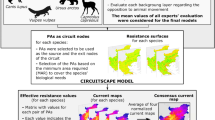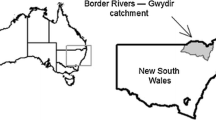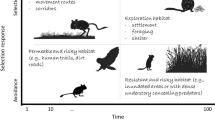Abstract
There is a vast body of literature aiming to predict, for a large number of taxa, the spatial distribution of suitable areas given the expected future changes of climatic conditions. However, such studies often overlook the role of landscape functional connectivity. This is particularly relevant for species with low vagility, as ground-dwelling insects, inhabiting areas with high human pressure due to habitat destruction and fragmentation, namely in the islands. In this study, we developed an individual-based model (IBM) that simulates individual movement according to landscape resistance and mortality probability, in order to derive the landscape movement map, and applied it to five endemic ground-dwelling insects of Terceira Island (Azores). We then confronted the movement maps of each species against the species distribution models previously developed for both current and future climatic conditions, quantifying the amount of important movement areas that are enclosed by the distribution polygons. We further sought to identify where habitat restoration would increase the overall connectivity among large habitat patches. Our results showed that, for both timeframes, the distribution models enclosed small amounts of areas predicted to be important for animal movement. Additionally, we predicted strong reductions (up to 94%) of these important areas for functional connectivity. We also identified areas in-between native forest of primary importance for restoration that may significantly increase the probability of persistence of our model species. We anticipate that this study will be useful to both conservation planners and ecologists seeking to understand species movement and dispersal both is islands and elsewhere.


Similar content being viewed by others
References
Adriaensen F, Chardon JP, De Blust G, Swinnen E, Villalba S, Gulinck H, Matthysen E (2003) The application of “least-cost” modelling as a functional landscape model. Landscape Urban Plan 64:233–247. https://doi.org/10.1016/S0169-2046(02)00242-6
Albert CH, Rayfield B, Dumitru M, Gonzalez A (2017) Applying network theory to prioritize multi-species habitat networks that are robust to climate and land-use change. Conserv Biol. https://doi.org/10.1111/cobi.12943
Allen CH, Parrott L, Kyle C (2016) An individual-based modelling approach to estimate landscape connectivity for bighorn sheep (Ovis canadensis). PeerJ 4:e2001. https://doi.org/10.7717/peerj.2001
Arellano L, León-Cortés JL, Ovaskainen O (2008) Patterns of abundance and movement in relation to landscape structure: a study of a common scarab (Canthon cyanellus cyanellus) in Southern Mexico. Landscape Ecol 23:69–78. https://doi.org/10.1007/s10980-007-9165-8
Avendaño-Mendoza C, Morón-Ríos A, Cano EB, León-Cortés J (2005) Dung beetle community (Coleoptera: Scarabaeidae: Scarabaeinae) in a tropical landscape at the Lachua Region, Guatemala. Biodivers Conserv 14:801–822. https://doi.org/10.1007/s10531-004-0651-x
Azevedo EB (2014) Plano de gestão dos recursos hídrico das ilhas Terceira, Graciosa, Jorge S, Pico, Faial, Flores e Corvo - Clima e Hidrologia de superfície. Centro do Clima, Meteorogia e Mudanças Globais da Universidade dos Açores
Azevedo EB, Reis FV (2016) Cenários climáticos para os Açores: Plano Regional das Alterações Climáticas (PRAC). Angra do Heroísmo, Açores
Barton KA, Phillips BL, Morales JM, Travis JMJ (2009) The evolution of an “intelligent” dispersal strategy: biased, correlated random walks in patchy landscapes. Oikos 118:309–319. https://doi.org/10.1111/j.1600-0706.2008.16936.x
Bellard C, Leclerc C, Courchamp F (2014) Impact of sea level rise on the 10 insular biodiversity hotspots. Global Ecol Biogeogr 23:203–212. https://doi.org/10.1111/geb.12093
Borges PAV, Serrano AR, Quartau JA (2000) Ranking the Azorean natural forest reserves for conservation using their endemic arthropods. J Insect Conserv 4:129–147. https://doi.org/10.1023/A:1009629012205
Borges PAV, Aguiar C, Amaral J et al (2005) Ranking protected areas in the Azores using standardised sampling of soil epigean arthropods. Biodivers Conserv 14:2029–2060. https://doi.org/10.1007/s10531-004-4283-y
Borges PAV, Lobo JM, de Azevedo EB, Gaspar CS, Melo C, Nunes LV (2006) Invasibility and species richness of island endemic arthropods: a general model of endemic vs. exotic species. J Biogeogr 33:169–187. https://doi.org/10.1111/j.1365-2699.2005.01324.x
Borges PAV, Vieira V (2010) List of arthropods (Arthropoda). In: Borges PAV et al (eds) A list of the terrestrial and marine biota from the Azores. Princípia, Cascais, pp 179–246
Borges PAV, Lamelas-López L, Amorim I et al (2017) Conservation status of the forest beetles (Insecta, Coleoptera) from Azores, Portugal. Biodivers Data J 5:e14557. https://doi.org/10.3897/BDJ.5.e14557
Cardoso P, Aranda SC, Lobo JM, Dinis F, Gaspar C, Borges PAV (2009) A spatial scale assessment of habitat effects on arthropod communities of an oceanic island. Acta Oecol 35:590–597. https://doi.org/10.1016/j.actao.2009.05.005
Cardoso P, Rigal F, Fattorini S, Terzopoulou S, Borges PAV (2013) Integrating landscape disturbance and indicator species in conservation studies. PLoS ONE 8:e63294. https://doi.org/10.1371/journal.pone.0063294
Chen I-C, Hill JK, Ohlemüller R, Roy DB, Thomas CD (2011) Rapid range shifts of species associated with high levels of climate warming. Science 333:1024–1026. https://doi.org/10.1126/science.1206432
Coulon A, Aben J, Palmer SCF, Stevens VM, Callens T, Strubbe D, Lens L, Matthysen E, Baguette M, Travis JMJ (2015) A stochastic movement simulator improves estimates of landscape connectivity. Ecology 96:2203–2213. https://doi.org/10.1890/14-1690.1
Courchamp F, Hoffmann BD, Russell JC, Leclerc C, Bellard C (2014) Climate change, sea-level rise, and conservation: keeping island biodiversity afloat. Trends Ecol Evol 29:127–130. https://doi.org/10.1016/j.tree.2014.01.001
DROTRH (2008) Carta de ocupação do solo da região Autónoma dos Açores - Projecto SUEMAC. Secretaria Regional do Ambiente, Direcção Regional do Ordenamento do território e dos Recursos Hídricos, Ponta Delgada
Elias RB, Gil A, Silva L, Fernández-Palacios J-M, Azevedo EB, Reis F (2016) Natural zonal vegetation of the Azores Islands: characterization and potential distribution. Phytocoenologia 46:107–123. https://doi.org/10.1127/phyto/2016/0132
Eycott AE, Stewart GB, Buyung-Ali LM, Bowler DE, Watts K, Pullin AS (2012) A meta-analysis on the impact of different matrix structures on species movement rates. Landscape Ecol 27:1263–1278. https://doi.org/10.1007/s10980-012-9781-9
Ferreira MT, Cardoso P, Borges PAV, Gabriel R, de Azevedo EB, Reis F, Araújo MB, Elias RB (2016) Effects of climate change on the distribution of indigenous species in oceanic islands (Azores). Clim Change 138:603–615. https://doi.org/10.1007/s10584-016-1754-6
Fischer J, Lindenmayer DB (2007) Landscape modification and habitat fragmentation: a synthesis. Global Ecol Biogeogr 16:265–280. https://doi.org/10.1111/j.1466-8238.2007.00287.x
Florencio M, Rigal F, Borges PAV, Cardoso P, Santos AMC, Lobo JM (2016) The role of plant fidelity and land-use changes on island exotic and indigenous canopy spiders at local and regional scales. Biol Invasions 18:2309–2324. https://doi.org/10.1007/s10530-016-1162-x
Gabriel R, Bates JW (2005) Bryophyte community composition and habitat specificity in the natural forests of Terceira, Azores. Plant Ecol 177:125–144. https://doi.org/10.1007/s11258-005-2243-6
Garcia RA, Cabeza M, Rahbek C, Araujo MB (2014) Multiple dimensions of climate change and their implications for biodiversity. Science 344:1247579. https://doi.org/10.1126/science.1247579
Gaspar C, Gaston KJ, Borges PAV, Cardoso P (2011) Selection of priority areas for arthropod conservation in the Azores archipelago. J Insect Conserv 15:671–684. https://doi.org/10.1007/s10841-010-9365-4
Gitay H, Suárez A, Watson RT (2002) Climate change and biodiversity. Intergovernmental Panel on Climate Change, Geneva
Gonçalves J, Dentinho T (2007) A spatial interaction model for agricultural uses. In: Koomen E, Stillwell J, Bakema A, Scholten HJ (eds) Modelling land-use change. Springer, Heidelberg, pp 133–144
Grimm V, Berger U, Bastiansen F et al (2006) A standard protocol for describing individual-based and agent-based models. Ecol Model 198:115–126. https://doi.org/10.1016/j.ecolmodel.2006.04.023
Grimm V, Berger U, DeAngelis DL, Polhill JG, Giske J, Railsback SF (2010) The ODD protocol: a review and first update. Ecol Model 221:2760–2768. https://doi.org/10.1016/j.ecolmodel.2010.08.019
Harter DEV, Irl SDH, Seo B, Steinbauer MJ, Gillespie R, Triantis KA, Fernández-Palacios J-M, Beierkuhnlein C (2015) Impacts of global climate change on the floras of oceanic islands: projections, implications and current knowledge. Perspect Plant Ecol 17:160–183. https://doi.org/10.1016/j.ppees.2015.01.003
Jenkins CN, Van Houtan KS, Pimm SL, Sexton JO (2015) US protected lands mismatch biodiversity priorities. Proc Natl Acad Sci 112:5081–5086. https://doi.org/10.1073/pnas.1418034112
Kier G, Kreft H, Lee TM, Jetz W, Ibisch PL, Nowicki C, Mutke J, Barthlott W (2009) A global assessment of endemism and species richness across island and mainland regions. Proc Natl Acad Sci 106:9322–9327. https://doi.org/10.1073/pnas.0810306106
Kleinmann JU, Wang M (2017) Modeling individual movement decisions of brown hare (Lepus europaeus) as a key concept for realistic spatial behavior and exposure: a population model for landscape-level risk assessment. Environ Toxicol Chem 36:2299–2307. https://doi.org/10.1002/etc.3760
Krosby M, Tewksbury J, Haddad NM, Hoekstra J (2010) Ecological connectivity for a changing climate. Conserv Biol 24:1686–1689. https://doi.org/10.1111/j.1523-1739.2010.01585.x
Lambin EF, Turner BL, Geist HJ et al (2001) The causes of land-use and land-cover change: moving beyond the myths. Glob Environ Change 11:261–269. https://doi.org/10.1016/S0959-3780(01)00007-3
Le Gall M, Chaput-Bardy A, Husté A (2017) Context-dependent local movements of the blue-tailed damselfly, Ischnura elegans: effects of pond characteristics and the landscape matrix. J Insect Conserv 21:243–256. https://doi.org/10.1007/s10841-017-9971-5
Machado A (2009) El Género Drouetius Méquignon, 1942 Stat. Prom., de las islas Azores (Coleoptera, Curculionidae, Entiminae). Graellsia 65:19–46
Martin TG, Burgman MA, Fidler F, Kuhnert PM, Low-Choy S, Mcbride M, Mengersen K (2012) Eliciting expert knowledge in conservation science. Conserv Biol 26:29–38. https://doi.org/10.1111/j.1523-1739.2011.01806.x
Mawdsley JR, O’Malley R, Ojima DS (2009) A review of climate-change adaptation strategies for wildlife management and biodiversity conservation. Conserv Biol 23:1080–1089. https://doi.org/10.1111/j.1523-1739.2009.01264.x
Maxwell SL, Fuller RA, Brooks TM, Watson JEM (2016) Biodiversity: the ravages of guns, nets and bulldozers. Nature 536:143–145. https://doi.org/10.1038/536143a
McGuire JL, Lawler JJ, McRae BH, Nuñez TA, Theobald DM (2016) Achieving climate connectivity in a fragmented landscape. Proc Natl Acad Sci 113:7195–7200. https://doi.org/10.1073/pnas.1602817113
McLane AJ, Semeniuk C, McDermid GJ, Marceau DJ (2011) The role of agent-based models in wildlife ecology and management. Ecol Model 222:1544–1556. https://doi.org/10.1016/j.ecolmodel.2011.01.020
McRae BH, Dickson BG, Keitt TH, Shah VB (2008) Using circuit theory to model connectivity in ecology, evolution, and conservation. Ecology 89:2712–2724. https://doi.org/10.1890/07-1861.1
Miranda P, Valente MA, Tomé AR, Trigo R, Coelho MFES., Aguiar A, Azevedo EB (2006) O clima de Portugal nos Séculos XX e XXI. In: Santos FD, Miranda P (eds) Alterações climáticas em Portugal: Cenários, impactos e medidas de adaptação. Gradiva, Lisbon, pp 45–113
Nardi G, Mico E (2010) Alestrus dolosus. The IUCN red list of threatened species 2010: e.T157633A5113198. https://doi.org/10.2305/IUCN.UK.2010-1.RLTS.T157633A5113198.en
Niebuhr BBS, Wosniack ME, Santos MC, Raposo EP, Viswanathan GM, da Luz MGE, Pie MR (2015) Survival in patchy landscapes: the interplay between dispersal, habitat loss and fragmentation. Sci Rep 5:11898. https://doi.org/10.1038/srep11898
Parmesan C (2006) Ecological and evolutionary responses to recent climate change. Annu Rev Ecol Evol S 37:637–669. https://doi.org/10.1146/annurev.ecolsys.37.091305.110100
Patiño J, Mateo RG, Zanatta F et al (2016) Climate threat on the Macaronesian endemic bryophyte flora. Sci Rep 6:29156. https://doi.org/10.1038/srep29156
Prevedello JA, Vieira MV (2010) Does the type of matrix matter? A quantitative review of the evidence. Biodivers Conserv 19:1205–1223. https://doi.org/10.1007/s10531-009-9750-z
QGIS Development team (2016) QGIS geographic information system. Open source geospatial foundation project. QGIS development team. Available from http://www.qgis.org/
Quartau JA, Borges P (2003) A new species of the genus Aphrodes curtis from the Azores (Hemiptera, Cicadellidae). Bocagiana 213:1–11
R Core Team (2015) R: A language and environment for statistical computing. R Foundation for Statistical Computing, Vienna. Available from https://www.r-project.org/
Railsback SF, Grimm V (2011) Agent-Based and Individual-Based Modeling: A Practical Introduction. Princeton University Press, Princeton
Rosenzweig C, Casassa G, Karoly DJ, Imeson A, Liu C, Menzel A, Rawlins S, Root TL, Seguin B, Tryjanowski P (2007) Assessment of observed changes and responses in natural and managed systems. In: Parry ML, Canziani OF, Palutikof JP, van der Linden PJ, Hanson CE (eds) Climate change 2007: Impacts, adaptation and vulnerability. Contribution of working group II to the fourth assessment report of the intergovernmental panel on climate change. Cambridge University Press, Cambridge, pp 79–131
Roslin T, Avomaa T, Leonard M, Luoto M, Ovaskainen O (2009) Some like it hot: microclimatic variation affects the abundance and movements of a critically endangered dung beetle. Insect Conserv Diver 2:232–241. https://doi.org/10.1111/j.1752-4598.2009.00054.x
Sala O, Chapin FS III, Armesto JJ et al (2000) Global biodiversity scenarios for the year 2100. Science 287:1770–1774. https://doi.org/10.1126/science.287.5459.1770
Taylor PD, Fahrig L, Henein K, Merriam G (1993) Connectivity is a vital element of landscape structure. Oikos 68:571. https://doi.org/10.2307/3544927
Travis JMJ (2003) Climate change and habitat destruction: a deadly anthropogenic cocktail. Proc R Soc B: Biol Sci 270:467–473. https://doi.org/10.1098/rspb.2002.2246
Triantis KA, Borges PAV, Ladle RJ et al (2010) Extinction debt on oceanic islands. Ecography 33:285–294. https://doi.org/10.1111/j.1600-0587.2010.06203.x
USGS (2015) United States geological survey. http://earthexplorer.usgs.gov/. Accessed Nov 1 2015
van Etten J (2017) R package gdistance: distances and routes on geographical grids. J Stat Softw 76. https://doi.org/10.18637/jss.v076.i13
van Vuuren DP, Edmonds J, Kainuma M et al (2011) The representative concentration pathways: an overview. Clim Change 109:5–31. https://doi.org/10.1007/s10584-011-0148-z
Wetzel FT, Beissmann H, Penn DJ, Jetz W (2013) Vulnerability of terrestrial island vertebrates to projected sea-level rise. Glob Change Biol 19:2058–2070. https://doi.org/10.1111/gcb.12185
Wilensky U (1999) NetLogo. Center for connected learning and computer-based modeling, Northwestern University, Evanston: http://ccl.northwestern.edu/netlogo/
Williams JC, ReVelle CS, Levin SA (2005) Spatial attributes and reserve design models: a review. Environ Model Assess 10:163–181. https://doi.org/10.1007/s10666-005-9007-5
Youngquist MB, Boone MD (2014) Movement of amphibians through agricultural landscapes: the role of habitat on edge permeability. Biol Conserv 175:148–155. https://doi.org/10.1016/j.biocon.2014.04.028
Acknowledgements
A special thanks to Pedro Neves and David Avelar, for facilitating the computational resources that significantly reduced the simulation time; Luís Dias and Rita Godinho, for all the help and GIS support; and Luís Borda de Água, Mário Boieiro and Carla Rego for all the discussion and helpful comments and inputs. Data on species distributions was gathered based on the project ATLANTISMAR—“Mapping coastal and marine biodiversity of the Azores” (Ref: M2.1.2/I/027/2011). We also thank the anonymous reviewers, whose comments helped improving the quality of our manuscript.
Funding
BAA was partially founded by Fundação para a Ciência e Tecnologia (FCT) Unit funding (Ref: UID/BIA/00329/2013). PAVB, EBA and RBE were funded by the project “Implications of climate change for Azorean Biodiversity—IMPACTBIO” [M2.1.2/I/005/2011]. FA was funded by Infraestruturas de Portugal Biodiversity Chair and Fundação para a Ciência e Tecnologia (FCT, SFRH/BPD/115968/2016).
Author information
Authors and Affiliations
Corresponding author
Ethics declarations
Conflict of interest
The authors declare that they have no conflict of interest.
Electronic supplementary material
Below is the link to the electronic supplementary material.
Rights and permissions
About this article
Cite this article
Aparício, B.A., Cascalho, J., Cruz, M.J. et al. Assessing the landscape functional connectivity using movement maps: a case study with endemic Azorean insects. J Insect Conserv 22, 257–265 (2018). https://doi.org/10.1007/s10841-018-0059-7
Received:
Accepted:
Published:
Issue Date:
DOI: https://doi.org/10.1007/s10841-018-0059-7




